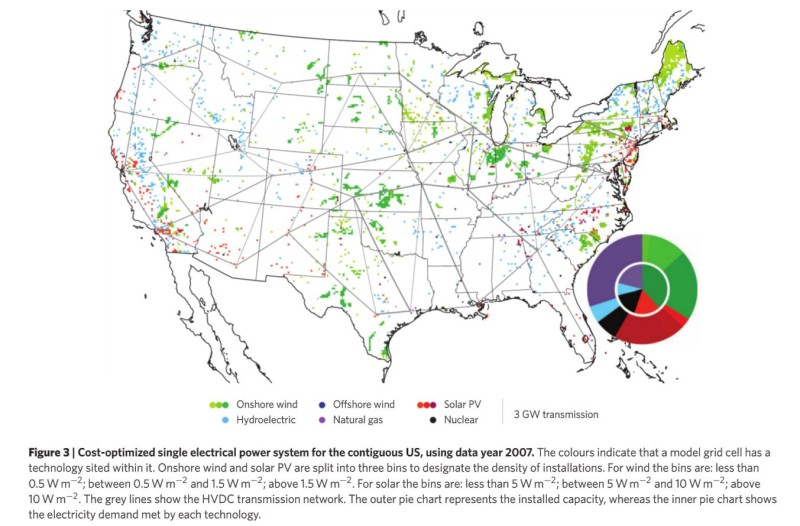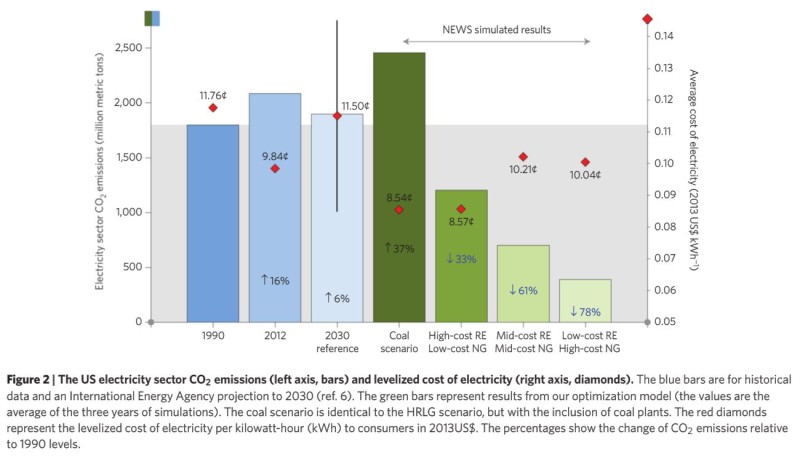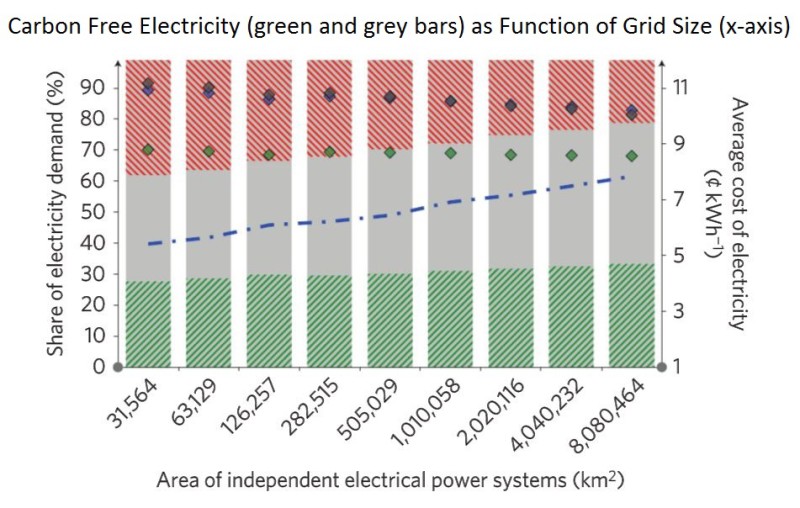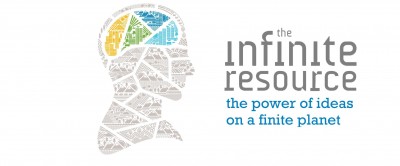How Far Can Renewables Go? Pretty Darn Far
This is part 4 of a series looking at the economic trends of new energy technologies. Part 1 looked at how cheap solar can get (very cheap indeed). Part 2 looked at the declining cost and rising reliability of wind power. Part 3 looked at how cheap energy storage can get (pretty darn cheap). Part 5 looks at how cheap electric vehicles can get, and how they’ll disrupt oil. Now let’s talk about how far renewables can go.
Renewables like solar and wind are plunging in price. But there are impediments to powering a grid entirely, or even primarily, with renewable energy. How far can they go? A new paper in Nature Climate Change suggests that wind and solar could power roughly 60% of the US’s electricity needs, given a national grid, without any energy storage, and without massive overbuild. Another roughly 20% of the grid’s electricity would come from carbon-free hydro and nuclear.
This paper is carefully done, and is likely quite conservative, as I’ll show below. The real fraction of grid electricity that solar and wind can provide is almost certainly higher, due to technology trends not reflected in the Nature Climate Change paper’s simulations.
The Headwinds Against Renewables
First, it’s worth looking at what gets in the way of renewables achieving high penetrations.
The core problem is intermittency. The sun doesn’t always shine. The wind doesn’t always blow. That creates two separate problems:
- The Physical Problem of Intermittency – How do you provide energy during those times? There are multiple options here, including overbuild (building far more solar/wind than one needs, so more is available during the low times) and energy storage. Both of those are part of the solution. Both face their own daunting issues.
- The Economic Problem of Intermittency (and Overabundance) – The second problem is more subtle. Wholesale electricity prices are substantially affected by supply and demand. Prices at the peak of demand (late afternoon and early evening) are much higher than prices in the middle of the night (when demand is low). Adding a large amount of solar, say, to the grid, floods the market with electricity at certain hours (daytime, particularly in the summer). That, in turn, lowers the wholesale price of electricity at those hours. That, in turn, makes it less profitable to build new solar – the price you can fetch for it on the market drops.
Problem #2 is thought of as solar and wind “eating their own lunch”.
Back in May of 2015, Jesse Jenkins and Alex Trembath ably described these headwinds in a post on “Is There an Upper Limit to Variable Renewables?” The article concludes that it’s tough to imagine a grid where solar + wind combined supply more than one third to one half of the electricity.
If you’re an energy geek, go read their post now. It’s one of the most cogent, data-based illustration of the challenges to deep decarbonization through renewables out there.
Renewables Can Go Much Further
While I agree with Jesse Jenkins and Alex Trembath in concept, their analysis misses some very important factors that increase the amount of solar and wind that can be integrated onto the grid. Three of those factors come to mind:
- Rising Capacity Factors – Solar and wind are getting better and better at producing energy more steadily, during more of the day. That’s especially true for wind power, where new turbines at high quality sites are expected to have capacity factors as high as 60%, making wind power increasingly reliable and increasingly less intermittent. More on this below.
- Energy Storage Price and Abundance – Energy storage is plunging in price. It’s headed for prices so low that it makes sense for grid operators to deploy huge amounts of it, even in the absence of solar or wind. Once it’s there, however, storage is a resource that changes the game for solar and wind. More on this below.
- Continent-Scale Grids – The wider the area that solar and wind are integrated over, the more reliable they become. Going from a grid the size of Texas or Germany (the models used in many studies) to a grid the size of the continental US or EU changes the game. That’s what this present study addresses.
A Continent is the Right Size for a Grid
The new study in Nature Climate Change looks at issue #3 – turning the US’s three separate grids into a single, integrated grid, linked by High-Voltage DC (HVDC) lines.
They simulated weather patterns and hourly electrical grid over a period of three years (by taking detailed data from 2006-2008 and extrapolating it to 2030) and made the system optimize the number and placement of solar and wind sites.
What they found is a grid like this:
Further, they found that making the US grid this comprehensive (as opposed to the three separate grids we have today) had benefits:
- Renewables Go Up – If you integrate over the size of the continental US, you can integrate more electricity from renewables.
- Costs Go Down – The overall cost of the plan is cheaper than the business-as-usual cost forecast for electricity in the US in 2030. And the wider the area you integrate, the cheaper.
Here’s one of the key charts, finding that in the low-cost renewables scenario (which is pretty conservative on cost), the US could lower electricity sector emissions by 78%, with an average retail cost of electricity that’s cheaper than the 2030 baseline case.
The second figure shows that, the larger the area one integrates over, the higher the percentage of grid electricity that can be supplied by carbon-free sources, getting up to a ballpark of 80% when the grid covers an area roughly the size of the continental US (8 million square kilometers). Roughly 60 out of that 80% would be wind and solar.
Why does linking power systems over a wider area help? There are multiple reasons.
- You can Bring in Power from the Best Sites – Wind power from the great plains and solar from the south are far cheaper than the alternatives. A large-scale-grid allows that cheap energy to reach the places where consumers are.
- Weather Doesn’t Correlate – Over the size of a state, weather patterns can be brutal for renewables. A bad summer storm can knock down solar output over most of Texas. A particularly calm weather system can slow wind turbines over hundreds of miles. But over the size of a continent, there’s minimal correlation in weather patterns. Sure, the sun or wind may be underperforming in one area – but they’re probably overperforming in another.
- The Sun Hasn’t Set Yet – In the West – Finally, the peak of electricity use starts in the late afternoon, and continues into the early evening. This is a problem for solar, given that the sun has already set by evening (by definition). But it hasn’t set a thousand miles to the west. So for east cost and midwestern cities, a national grid can bring in solar electricity from states west of them for those critical early evening hours.
This is Still A Deeply Conservative Study
While this study’s findings are encouraging, I find that the assumptions in it remain conservative.
- Solar and Wind Cost – In the study’s “low cost” renewables scenario, solar CapEx plus OpEx drops to $1.19 per Watt by 2030. On-shore wind CapEx plus OpEx drops to $2.16 per Watt by 2030. These numbers are likely to be beaten by 2020. Actual numbers in 2030 (after adjusting for rising capacity factor) may be half this expensive. That would mean twice as much solar and wind electricity per dollar.
- Rising Capacity Factors – The Nature Climate Change paper seemed to assume that capacity factors for solar and wind in 2030 are essentially the same as today.
- No Storage – This Nature Climate Change paper doesn’t model the inclusion of energy storage at all.
In a real world, with solar and wind prices dropping much further than this study sees by 2030; with wind, in particular, having a higher capacity factor (meaning that it blows more steadily); and with energy storage plunging in price, 60% of electricity from solar and wind is a low, conservative estimate.
The Other Aces for Renewables
We’ve discussed continent-scale grids. Now let’s go into the other two reasons solar and wind can go substantially farther than projected by most analysis: Rising capacity factors, and cheap and abundant storage.
1 – Rising Capacity Factors
A key point in Jesse and Alex’s analysis (and in other analyses they base theirs on) is the limitation imposed by the capacity factor of renewables. In general, it’s tough to imagine an energy source producing a higher percent of a grid’s electricity than its capacity factor.
The capacity factor is a measure of how much of its potential energy production a renewable source (like a solar array or a wind farm) actually produces. A solar array may be rated for 100 megawatts. That’s the maximum amount it can produce. But if it’s in Alaska, it may only produce an average of around 10 megawatts. Even in sunny places like southern California, capacity factors are somewhere around 30%. Half the day, the sun isn’t shining at all. And another 20% or so of the possible energy is lost due to clouds, poor angles of the sunlight (at dusk or dawn), occlusion, etc..
What Alex and Jesse miss (because the analysis they base their article on miss it) is the rising capacity factors of solar power and (especially) wind power.
In 2010, new solar power in the US had an average capacity factor of under 25%. In 2012, it was 30%.
Wind is even more impressive. Today, a best-class wind site in the US might have a capacity factor of 40%. But NREL expects next-generation wind turbines to reach an incredible 60% capacity factor over almost a quarter of the US in the next decade.
In short, current models of solar and wind that penalize them for being variable are increasingly out-of-date, or seem likely to become so. Solar and wind are variable, but they’re less so than they used to be.
2 – Cheap and Abundant Energy Storage
I’ve written extensively about how energy storage prices are plunging. That, in turn, stands to change the game for renewables.
Jesse and Alex do make a nod to energy storage in their analysis of the limits of renewables. They point to the oddly conservative MIT Future of Solar study’s discussion of energy storage. That study finds that in a Texas-sized grid (technically an “ERCOT-like grid”, which means the same thing) having 100 Gigawatt-hours of energy storage slows the rate at which solar “eats its own lunch” by roughly half, but doesn’t totally eliminate it. With 100 GWh of storage, solar can reach 42% capacity at a price of around 60 cents per watt.
That is actually quite a fine result. The Texas grid in the US consumes about 50 GWh of electricity per hour. So 100 GWh of storage is around 2 hours of storage for the full grid. That is, by today’s standards, an almost incomprehensibly huge amount. But for a future grid, it’s not. It’s actually less storage than the grid would benefit from in a cheap-storage world, simply for the purpose of leveling out the daily supply/demand cycle.
Texas is somewhere on the order of 2% of world electricity demand. So if Texas had 100 GWh of storage, one might expect that the world as a whole would have 50 times that (1 divided by 2%), or roughly 5,000 GWh of storage. That is a point at which it’s quite conceivable that grid electricity storage would cost as little as 2 cents per kwh.
Today, for customers of Entergy in Texas, electricity consumed at the peak hours costs 14.4 cents per kwh, vs 2.4 cents per kwh for off-peak electricity. If energy storage costs less than the 12 cent gap between those two, it will be deployed. And the total amount that could be deployed profitably could be on the order of one third to one half of Texas’s daily electricity consumption. 2 cents per kwh storage would be a no-brainer. Even 6 cents per kwh storage would see many hours worth of storage deployed.
That’s perhaps 400 GWh – 600 GWh of storage which makes economic sense to deploy on its own merits in a Texas-sized grid. That’s 4x – 6x as much as was modeled in the MIT “Future of Solar” study. That storage on the grid would, as a side effect, create ample capacity for solar and wind to sell their excess energy into on a daily basis, effectively removing the “eats its own lunch” problem of oversupply for solar and wind.
Short version: Storage looks likely to get cheap enough that it will be deployed in large quantities, paving the way for wind and solar.
Renewables Have Powerful Tail Winds
In summary, three factors will help drive renewables forward (even over and above the the plunging prices of solar and wind).
- Rising Capacity Factors – Such as for wind power.
- Cheap and Abundant Storage – Cheap, abundant energy storage now seems likely.
- Continent-Sized Grids – Of all the tail-winds, this is the one that most needs assistance from policy. Yet it makes sense. Integrating the grid over a wider area reduces costs for consumers and makes it easier to integrate more renewables.The next time someone complains about renewables in Germany or shows you a paper using a simulation of a Texas-sized grid, ask why it’s not a simulation of a continent-sized grid.
Are those three enough to reach 100% clean electricity? Maybe, maybe not. But they can very likely get us 90% or more of the way there.
—-
There’s more about the exponential pace of innovation in both storage and renewables in my book on innovating in energy, climate, food, water, and more:The Infinite Resource: The Power of Ideas on a Finite Planet
Clean energy, Climate change, Economics, Energy storage, Grid, Renewables, Solar, Wind
31 Jan, 2016




